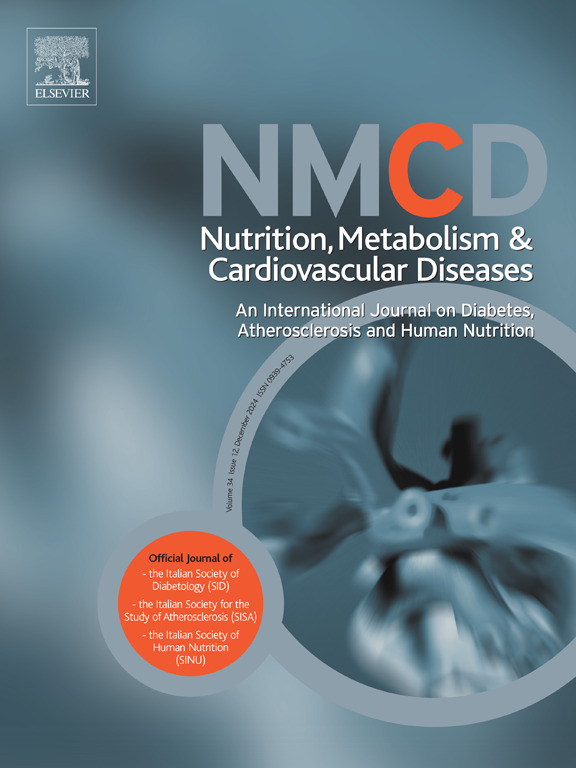全身振动运动对超重和肥胖女性心肺健康、肌肉力量和体脂的影响:一项随机先导研究
IF 3.7
3区 医学
Q2 CARDIAC & CARDIOVASCULAR SYSTEMS
Nutrition Metabolism and Cardiovascular Diseases
Pub Date : 2025-03-17
DOI:10.1016/j.numecd.2025.104019
引用次数: 0
摘要
背景与目的:全身振动(WBV)运动已被公认为一种改善功能的替代运动方法。我们研究了8周WBV运动对年轻女性心肺功能(CRF)、肌肉力量(MS)和身体成分的影响。方法与结果:将26例体重超重、肥胖且不活动的女性(年龄:30.2±8.0岁,BMI: 25.7±1.9 kg/m2)随机分为腹肌体积运动组(n = 13)和对照组(n = 13)。WBV锻炼组在振动平台上进行静态和动态锻炼(3次/周,每次60分钟),持续8周。对照组保持他们的日常生活方式,没有进行有组织的锻炼。CRF以vo2峰值测量,MS指数以胸压和腿压的1-RM (kg)测量,相对于体重(kg)表示。采用生物电阻抗法测定体成分。在随机分配的26名参与者中,23名参与者(13名WBV和10名对照组)完成了干预,运动坚持率为94.2%。双向重复测量方差分析显示,与对照组相比,WBV运动组的体脂(-2.8 kg)和腰围(-3.5 cm)减少(p < 2)。VO2peak(术前:27.9±4.8 vs后:30.7±4.4 ml/kg/min, p = 0.005)和MS指数(术前:2.0±0.4 vs后:3.0±0.7,p)结论:WBV运动能有效改善年轻超重肥胖女性的体能和体脂。本文章由计算机程序翻译,如有差异,请以英文原文为准。
Effects of whole-body vibration exercise on cardiorespiratory fitness, muscular strength and body fat in women with overweight and obesity: A randomized pilot study
Background and aim
Whole-body vibration (WBV) exercise has been acknowledged as an alternative exercise method for improving functional capacity. We examined the effects of an 8-week WBV exercise on cardiorespiratory fitness (CRF), muscular strength (MS) and body composition in young women.
Methods and results
Twenty-six inactive women with overweight and obesity (age: 30.2 ± 8.0 years, BMI: 25.7 ± 1.9 kg/m2) were randomly assigned to WBV exercise (n = 13) or control (n = 13) groups. The WBV exercise group participated in static and dynamic exercises on a vibration platform (3 sessions/week, 60 min/session) for 8 weeks. The control group maintained their usual lifestyle without structured exercise. CRF was measured by VO2peak and MS index was measured by the 1-RM (kg) for the chest and leg press, expressed relative to body weight (kg). Body composition was assessed by bioelectrical impedance analysis. Of the 26 participants randomized, 23 participants (13 WBV and 10 controls) completed the intervention, with 94.2 % exercise adherence rate. A two-way repeated measures ANOVA revealed that the WBV exercise group had reductions (p < 0.05 for all) in body weight (−2.4 kg), BMI (−0.9 kg/m2), body fat (−2.8 kg) and waist circumference (−3.5 cm) compared to the control group. VO2peak (pre: 27.9 ± 4.8 vs. post: 30.7 ± 4.4 ml/kg/min, p = 0.005) and MS index (pre: 2.0 ± 0.4 vs. post: 3.0 ± 0.7, p < 0.001) increased in the WBV exercise group, but not in the control group.
Conclusion
WBV exercise is effective for improving fitness and body fat in young women with overweight and obesity.
求助全文
通过发布文献求助,成功后即可免费获取论文全文。
去求助
来源期刊
CiteScore
6.80
自引率
2.60%
发文量
332
审稿时长
57 days
期刊介绍:
Nutrition, Metabolism & Cardiovascular Diseases is a forum designed to focus on the powerful interplay between nutritional and metabolic alterations, and cardiovascular disorders. It aims to be a highly qualified tool to help refine strategies against the nutrition-related epidemics of metabolic and cardiovascular diseases. By presenting original clinical and experimental findings, it introduces readers and authors into a rapidly developing area of clinical and preventive medicine, including also vascular biology. Of particular concern are the origins, the mechanisms and the means to prevent and control diabetes, atherosclerosis, hypertension, and other nutrition-related diseases.

 求助内容:
求助内容: 应助结果提醒方式:
应助结果提醒方式:


